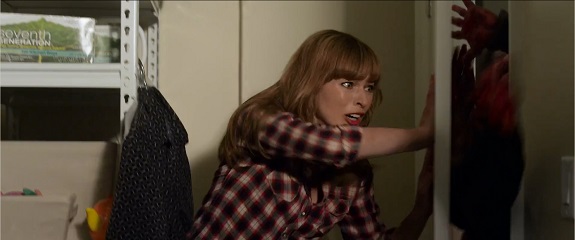
Resident Evil: Retribution is the latest and so far last movie in the Resident Evil franchise. It starts with about ten minutes of recap of the previous movies, after which “Alice” wakes up as a housewife with a husband and a daughter. Cue a few minutes of syrup before the zombies attack. All of which turns out to be a danger room scenario, which the series is inordinately fond off.

Real Alice meanwhile has been captured and is interrogated by evil Jill Valentine, which eats up a couple more minutes, before a power shutdown, which interestingly also shutdowns Valentine, allows her to escape. Despite the deadline she takes the time to pose here. To be honest, it is a nice shot of Alice in her badass uniform, against that white, sterile Umbrella corps background. Note the change in hair colour and length here.
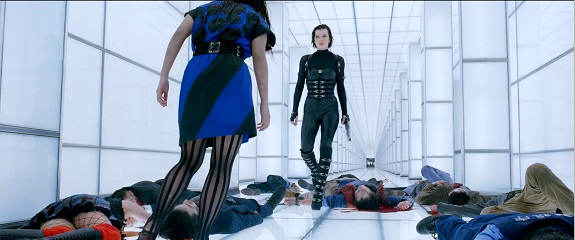
The first real Alice set piece sees her re-enacting the zombie infection of Tokyo, which we know from the last movie but which is news to her. The last zombie facing off against Alice is in fact patient zero. This shot shows off everything I like about her: calm, cool, in control.

Enter Wesker, the scumbag villain from the previous movie, the one who made everything worse and is now reassuring Alice that really, honestly, he’s on the side of angels and it’s the Red Queen AI who’s been behind the Umbrella Corp’s actions. Turns out she wants to wipe out the human race, which considering their track record in the previous movies, means she must be carrying out Umbrella’s true wishes.
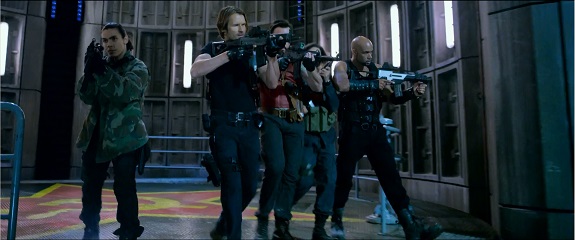
Wesker has sent a team of professionals to the rescue, including floppy haired Leon, who’s a much more important character in the video games. Here he’s just another bloke with a gun.
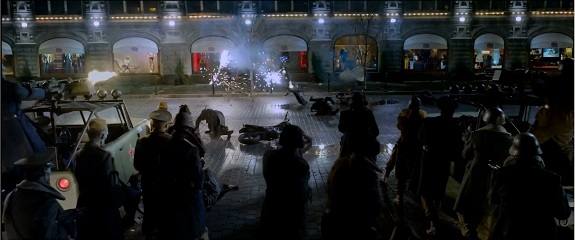
As the series has progressed, the bullshit has increased, from zombies to super zombies and here we have zombies intelligent enough to use weaponry and jeeps, something not seen in previous movies, so why now? Because it looks cool, probably, and normal zombies aren’t much of a threat anymore.

Meanwhile, despite dying in the first movie, that bloke in the middle is Alice’s boyfriend brought back to life by the Red Queen, as are the other non-mooks there. Alice meanwhile has gotten fake Alice’s daughter. The woman in the impractical dress is Ada Wong, yet another mysterious bad ass from the games brought into what’s essentially a drawn out cameo here.
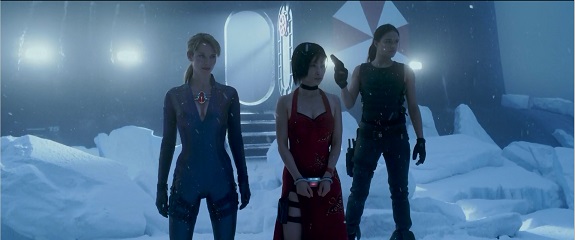
The climax comes with an extended battle on the ice, as brainwashed Jill Valentine goes mano a mano (wait, that’s not quite right) with Alice, while Rain on the right (also killed in movie 1) goes after the rest of the team, now reduced to Ada, Leon and that rapper dude from the previous one. The one true strength of the Resident Evil movies remains that it has so many kick ass women in it: Alice, Valentine, Ada, Claire Renfield, Rain.
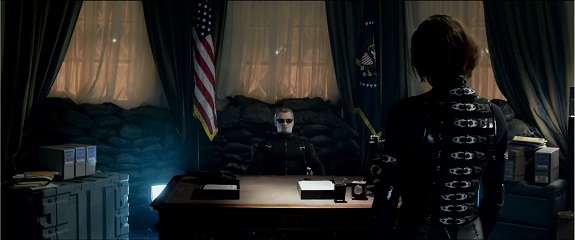
The movie ends with Alice meeting up with Wesker again, who now is the most powerful man in the world, holed up in the White House, defended by Umbrella and US army troops, the last surviving humans in the world, the logical end result of all of Umbrella’s scheming through the previous movies. Getting stuck in the White House, not the most defensible position in the world, being a prime example.










